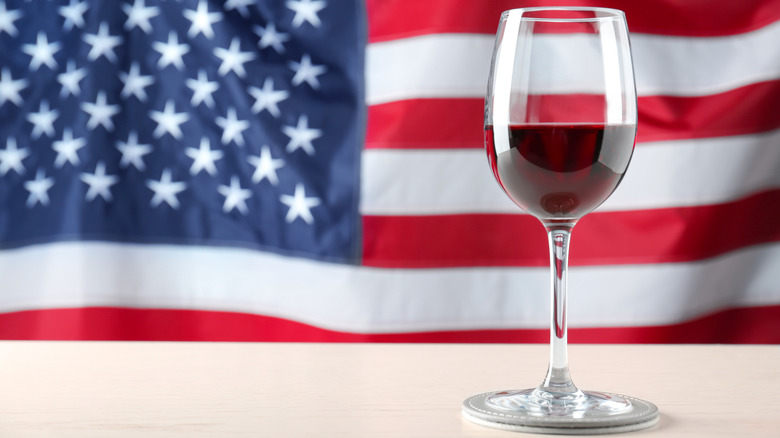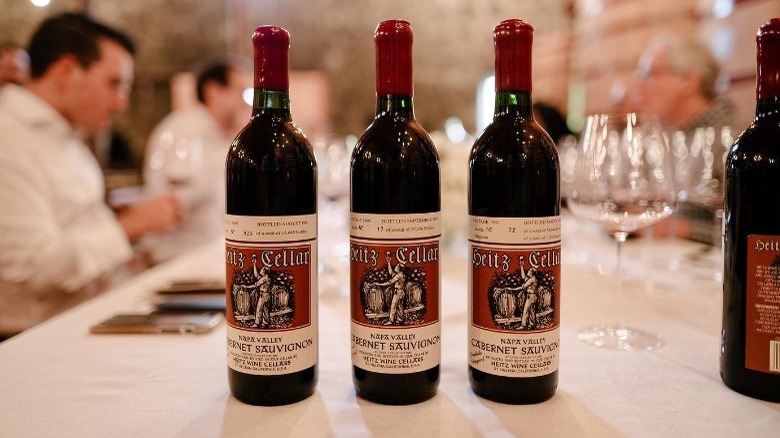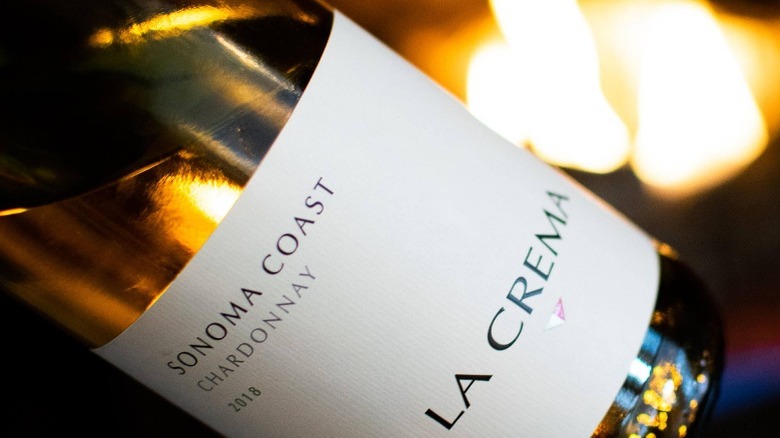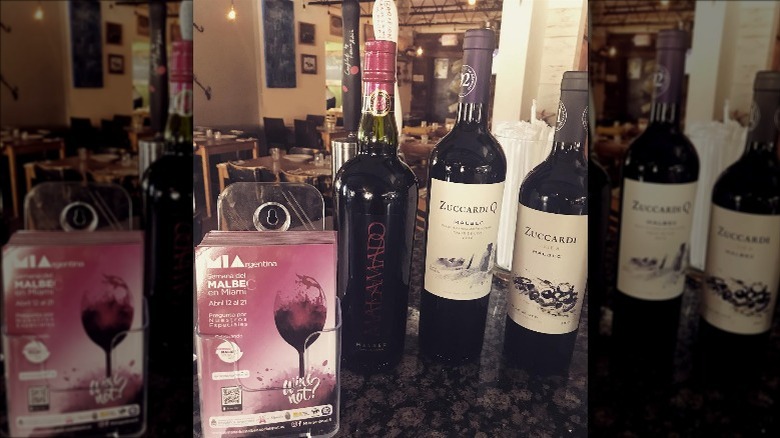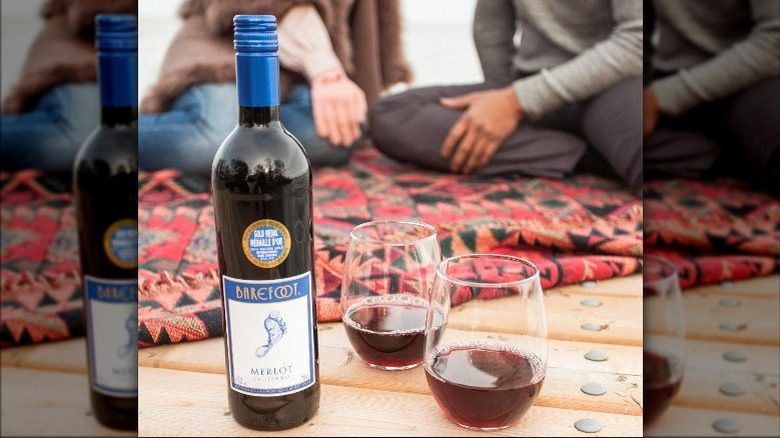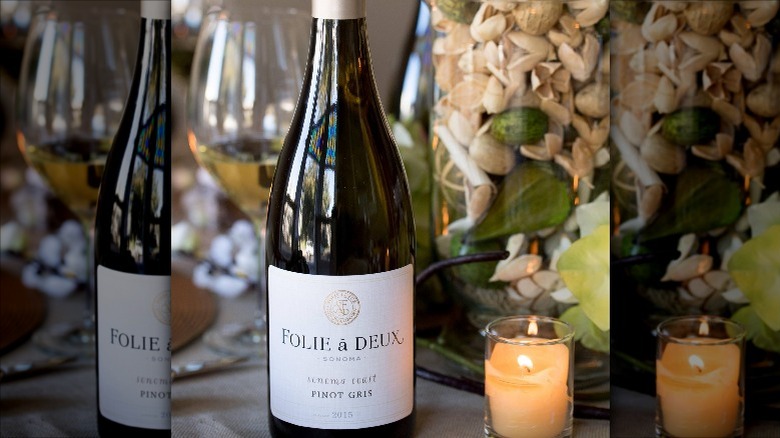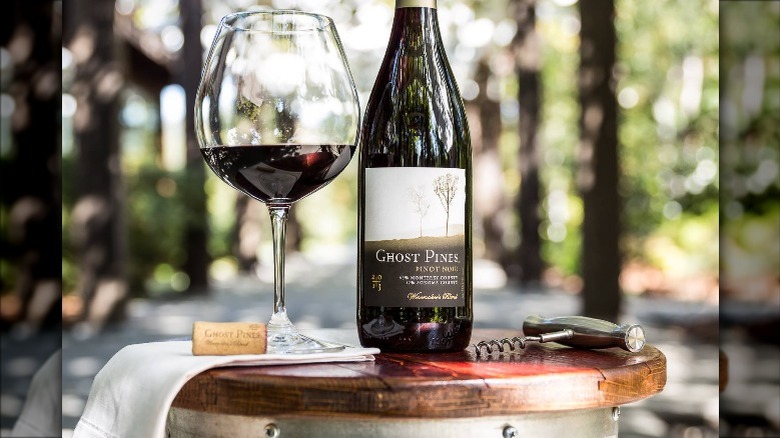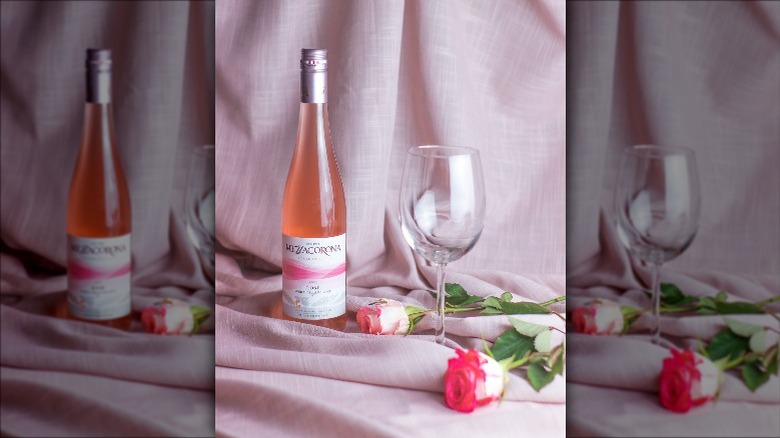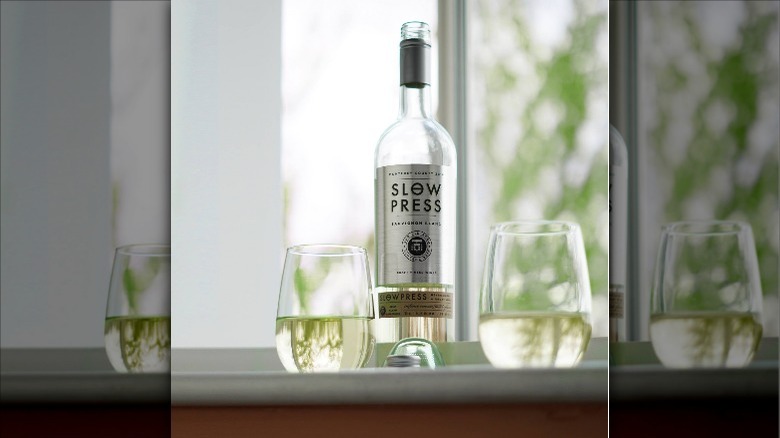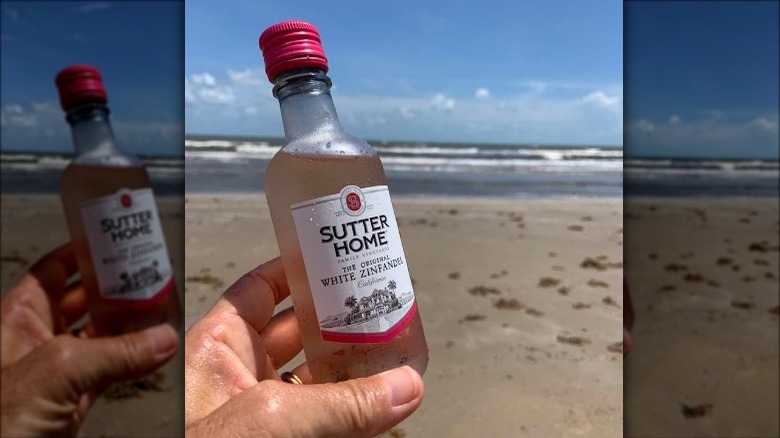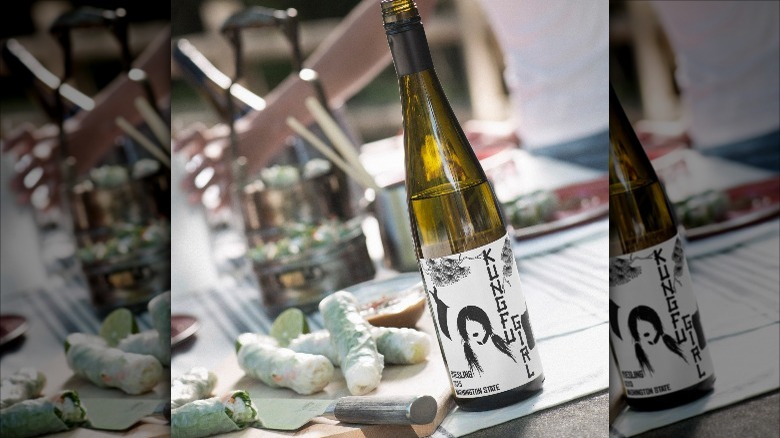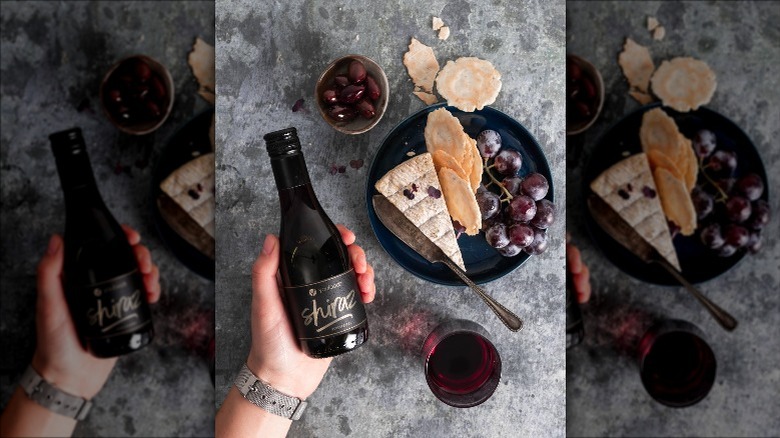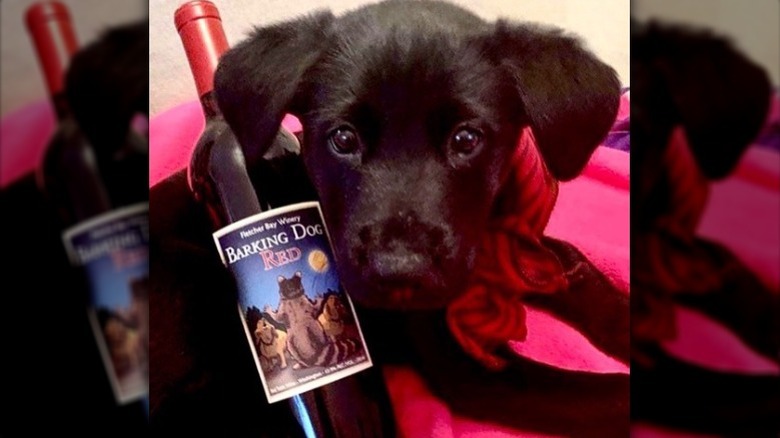This Is Your State's Favorite Wine
If we all scream for ice cream, then do we all whine for wine? Well, maybe not all of us. A 2021 Gallup survey found that 31% of Americans aged 18 and up drink wine. (We're going to assume Gallup did not ask the 18-to-20s how they were obtaining the stuff.) This makes it the third-most-popular alcoholic beverage choice, coming in ahead of the hard stuff (27%) but behind beer (39%) and no booze at all (40%).
Among wine drinkers, though, there's no consensus on what type of wine is best. As with beers and cocktails, preferences vary from state to state. According to data gathered by Wisevoter, some states enjoy a hearty red while others like a dry white, and still others (winestagrammers, perhaps?) prefer their wines pretty in pink. Do you think you can guess what your state's favorite might be? You might be right on the nose (a balanced aroma with just a slight hint of je ne sais quoi) or you might be in for a (bottle) shock. If your hometown doubles as our nation's capital, however, prepare yourself for a disappointment: once again, the District of Columbia gets dissed as its data was not deemed worthy of inclusion in Wisevoter's list.
Cabernet sauvignon is a classic
Cabernet sauvignon, a full-bodied red, is one of the world's best-known wines. It derives from grapes of French origin, but many of the top cabernets come from California. In fact, the Trefethen winery notes that cabernet's popularity really took off after a 1976 competition that went down in history as the "Judgment of Paris." This contest (no relation to the mythic Greek one that bears the same name) pitted France's top wines against California cabernets and to everyone's shock, team USA took home the win. While other popular wines have peaked and faded since that time, cab sav is still holding strong — and strong is one word you could use to describe how it tastes, as well. This wine is known for its dark red color, heavy tannins, and a flavor that includes elements of blackcurrant and bell pepper as well as oak.
Cabernet sauvignon is the second-most popular wine on the list if you go by the number of states where it came out on top (although admittedly the results are not weighted by population or any other factor). It's been favorited by 10 different states, these being Alabama, Idaho, Illinois, Kentucky, Michigan, Oregon, Tennessee, Texas, Utah, and West Virginia. A disparate lot, to be sure, but these states all know a classic when they see one and don't mind sticking with something so tried and true.
Chardonnay's still hanging in there, too
Chardonnay, as per The Washington Post, is the world's most popular white wine, with Sonoma County Tourism adding that it, like cabernet sauvignon, really started to take off in the U.S. after it, too, made a good showing in the aforementioned "Judgement of Paris." In fact, so popular did chardonnay become that it even entered the lexicon of baby names. The wine (not the babies) is a dry white, one that's been known to taste strongly of the oak barrels in which it's typically aged. In recent years, though, there's been a trend towards toning down some of the oak, while some chardonnays are no longer oak-aged at all. Chardonnays can have a green apple fruitiness to them, or they can tend towards the creamy or taste of vanilla, but despite wine reviewers' fondness for the word "buttery," a good chardonnay really should not taste of the stuff.
Whether buttery, oaky, or otherwise, chardonnay comes out on top in a northern state (Maine), a southern one (Louisiana), two midwestern ones (Iowa and Ohio), and one hard-to-classify one (Missouri). Chardonnay is a great choice for all of these states as it complements Maine lobster and jambalaya just as well as it does Iowa corn dogs, Kansas City burnt ends, and even Cincinnati chili.
Malbec is a dark horse that's starting to break out of the pack
Malbec, another dry red, is a wine of French origin that found its footing in Argentina. According to Wine Folly, 75% of all Malbec today is produced in this country, and Argentina could in fact be credited with saving or at least popularizing this wine variety. Malbec isn't as tannic as cabernet, nor does it have such an oaky flavor. Its dominant note could be said to be that of blueberries, while it also has some raisin flavor to it along with other dark fruits such as cherries and blackberries. Other notes include chocolate, coffee, and tobacco.
Malbec isn't quite as popular as some of the other wines on this list, perhaps due to its not being domestically produced, but did come out #1 in Nebraska. That checks out, since Malbec complements the Cornhusker State's runzas as well as it does Argentinian empanadas. Outside of Nebraska, Malbec is on some other states' radar, as well: Delaware, Georgia, Kansas, Louisiana, Massachusetts, Montana, New Hampshire, South Dakota, Utah, and Wisconsin all had this wine as one of their top five picks.
Many people still favor merlot
Merlot is somewhat similar to cabernet sauvignon, although it is usually both softer and fruitier and not so heavy on the tannins. It's also a wine with a somewhat complicated backstory. For years Merlot played second fiddle (or perhaps even further back in the orchestra) to cab sav, but suddenly in the '90s it went viral (or whatever we called it back then) and transformed into the decade's must-have wine. This was great while it lasted, but every boom must have its bust and by the mid-00s GuildSomm says the trendy crowd were just so over merlot. Its true death knell may have occurred when a character in the popular wine country road trip movie "Sideways" emphatically declared "I am not drinking any [word that autocorrect would render as 'ducking'] Merlot!"
It's possible, though, that merlot's fall from grace may have actually done it a favor in a way as it allowed the wine to retain its integrity and high quality. Nearly two decades after merlot was canceled, though, it appears to be staging somewhat of a comeback.
This wine is particularly popular in two of the "n" states: New Mexico and North Dakota. Other states, however, appear to be jumping back on board the merlot train, too, as it's a solid top-five safety pick in Arkansas, Connecticut, Delaware, Indiana, Kentucky, Maine, Michigan, Missouri, Montana, Nebraska, New Hampshire, New York, Oregon, Pennsylvania, Rhode Island, Tennessee, Utah, Virginia, West Virginia, and Wisconsin.
Pinot gris by any other name would still have its fans
If you're unfamiliar with pinot gris, you may know it better under its alternate nom de vin, pinot grigio. Pinot gris is actually a sub-variety of pinot grigio, as is pinot blanc, with all three of these white wines being made from a white (or gray) mutation of the pinot noir grape. So, if pinot gris is essentially a mutant, does this means it has a superpower? Of course it does! It has the power to appeal to people who don't care for chardonnay due to the fact that it is lighter in body and has a taste that's a bit tarter and sweeter.
Pinot gris (and/or grigio) is a wine that may still be finding its audience seeing as how it only comes out on top in three states: Hawaii, Vermont, and Wyoming. Like most dry whites, pinot gris goes well with food and we feel it would be an excellent partner for fresh pineapple as well as aged Vermont cheddar. As for the Wyoming state specialty of Rocky Mountain oysters (spoiler: not really oysters), we have no clue what you'd want to pair with those (a nice glass of Alka Seltzer, perhaps?), but a bottle of pinot gris would certainly help you make the best of this meal.
Pinot noir's still a popular pick
Pinot noir is a wine that's far better known than its paler cousin. The reason for this may well be the same movie that knocked Merlot off the charts, the cult classic "Sideways" As GuildSomm recalls, the movie, which was very pro-pinot, seemingly catapulted this wine into the stratosphere overnight. Prior to pinot noir's breakout role, this grape was so low on the wine totem pole that it was often used in box blends — and this during an era when boxed wine didn't exactly have the best reputation. Once the movie came out, though, no-one was drinking merlot anymore and the mid-00s were all about pinot noir.
Pinot noir may no longer be at the peak of its popularity, but it hasn't slipped too far. This wine, which is lighter in body and yet has a more earthy flavor than merlot, is still a top seller in eight different states. Colorado, its next-door neighbor Kansas, and its fellow Rocky Mountain state Montana are all big fans, as is Nevada. The New England states of Massachusetts and New Hampshire also have pinot noir as their number one pick, as do Virginia and Mississippi down South. Even on the West Coast, pinot noir is still in demand as it ranks as Oregon's second choice, California's third, and holds down the fifth-place spot in Washington state.
Rosé may be on the wane
Back in the mid-2010s, a once-downmarket pink wine suddenly got trendy. By the end of that decade, though, rosé all day was well on its way to becoming a cliché. As to the sudden rise of this highly photogenic wine, Pure Wow credits Instagram, of course. The fact that rosé seems to be slipping in the ratings, however, may be due to the fact that every fad has its sell-by date. If this were five years ago, rosé would likely have captured a far larger market share — perhaps not the darling of all 50 states, but the favorite of at least half, for sure. Lately, however, this wine hasn't been doing quite as well as it once did.
Still, it's not like #nowayrose is the latest trending hashtag. This pink drink remains the first choice of wine drinkers in Arizona, Georgia, Minnesota, and Oklahoma and also makes the top five list in Arkansas, California, Colorado, Connecticut, Hawaii, Idaho, Illinois, Massachusetts, Maryland, Michigan, Mississippi, Missouri, Montana, Nebraska, Nevada, New Jersey, New Mexico, New York, North Carolina, North Dakota, Rhode Island, South Carolina, Texas, Vermont, and Wyoming. Adding up the numbers, it seems rosé still holds some sway in 29 out of 50 states, so it won't be slipping back into obscurity quite yet.
Sauvignon blanc is having a moment
If rosé is (almost) passé, what's the 2020s vin du jour? While it's still fairly early in the decade, it looks like sauvignon blanc is what all the cool kids are drinking. Sauvignon blanc is a dry white that VinePair describes as having a "grassy" flavor, which is a descriptor often applied to chardonnay, as well. Unlike chardonnay, however, sauvignon blanc is generally not aged in oak, nor is it typically called "buttery."
Although sauvignon blanc grapes originate in France, New Zealand is the region that really put this style of wine on the map. Now that sauvignon blanc has grown so popular, though, Chilean, South African, and Californian vintners have also gotten in on the game.
Taking a look at the lengthy list of states — 16 in all — where sauvignon blanc reigns supreme, it's easy to see that this is currently one of the most popular wines in the U.S. After all, four of the sauvignon blanc states are also in the top five for population: California, Florida, New York, and Pennsylvania. The dozen less-populous states that also favor this wine are Alaska, Connecticut, Delaware, Indiana, Maryland, New Jersey, North Carolina, Rhode Island, South Carolina, South Dakota, Washington, and Wisconsin. North to south, east to west, tiny states to huge ones, it seems that sauvignon blanc is quite literally all over the map. In fact, there are only a handful of states that don't have it in their top five.
Even white zinfandel (aka the other pink wine) hasn't been forgotten
Back in the '70s, Sutter Home's vintners were experimenting with Zinfandel and wound up with a pretty pink wine as a byproduct. They bottled it and marketed it as white zinfandel, but at first this new wine was a so-so seller. As VinePair relates, though, a 1975 fermentation accident led to an extra-sweet batch. Go figure, everyone loved it and sweet white zinfandel took off like a rocket. (Before you sneer at 1970s tastebuds, take a moment to recall the moscato boom of the 2010s. Sweet wines cycle in and out of fashion just as dry ones do.)
The ironic thing about white zinfandel is, while it's technically a rosé, it was never marketed as such since Sutter Home wanted to avoid the downmarket reputation of a wine that was then seen as cheap, nasty plonk. Wow, how things change once you roll over the calendar to a new millennium. Even with rosé' having redeemed itself, though, there's one place that remains loyal to the 1980s favorite wine: Arkansas, which is also one of the few states opting out of the sauvignon blanc ballyhoo. (They do like their rosé as well, as it comes in at their #3 spot). Not only is white zinfandel popular in the Natural State, though, but it's also a top-five pick in four other bold states that are unafraid to appear unfashionable: Iowa, Kansas, New Hampshire, and Tennessee.
Riesling's a solid runner-up
While the above nine wines are the only ones that hold a top spot in at least one state, there are a few others that merit an honorable mention because they appear in multiple state's top five lists. Riesling, a white wine of German origins, has a particularly strong showing, one that is perhaps due to its balanced flavor profile. While this wine is typically somewhat sweet, it also has plenty of acid that lends it some citrus notes. Wine Folly has observed a recent trend toward drier rieslings, as well. Rieslings are often suggested as a pairing for spicy foods because their sweet/tart flavor is said to help temper some of the heat.
The states that are fondest of riesling, however, aren't especially known for their chile-spiked cuisine — it's the second-most popular wine in both Alaska and West Virginia, while it takes third place in Indiana and Nebraska. A wider range of states, though, have riesling as their fourth choice, these being Alabama, Arizona, Hawaii, Nevada, Tennessee, and Washington. It also rounds out the top five in both Colorado and North Dakota.
Super-dry shiraz has some supporters
Shiraz, which is sometimes known as syrah, is a red wine so dark that it almost looks black in the bottle. It's super-dry, heavy on tannins, and basically heavy in general. Many of these wines come from Australia — in fact, Shiraz is the Australian variant of the name. VinePair suggests it might even be a phonetic spelling of an Australian-accented "syrah," which is the name this wine goes by in its native France. While Shiraz is one of the healthiest types of wines due to the number of antioxidants it contains, it's not what you'd call an easy drinker, although it does go very well with hearty cuts of meat. For a double antioxidant punch, you could also pair it with some high-cacao dark chocolate.
While shiraz does not take the top spot in any state, nor did it come in a close (or distant) second, It did earn the bronze (third place) in Alaska, Louisiana, and Tennessee. In Hawaii, Massachusetts, and Pennsylvania it managed a fifth-place finish.
Maine's mystery wine
One wine appeared on just a single state's list, where it occupied the number two spot: apparently, in Maine, they're pretty fond of something called "mutt." Okay, we love us some mutts as well, but we're thinking of the canine kind. What, pray tell, is "mutt wine?" Could it be a typo? We decided to do some investigation and found an Australian winery called Rusty Mutt, but that doesn't seem too likely since in all other cases the wines on the list are types, not specific labels. There's also a Sonoma County winery called Mutt Lynch that bills itself as particularly dog-friendly, which is awesome, but still unlikely to be the answer we're looking for.
Buried further down in the Google results, however, we found a more likely definition. Mutt wine, according to a 2003 Seattle Times article, is a term that the writer uses to describe "mixed-breed, budget red wines." So, pretty much a red blend, then. Okay, mystery (maybe) solved, but, you know, a footnote or parenthetical explanation would be nice so we could know for sure.
